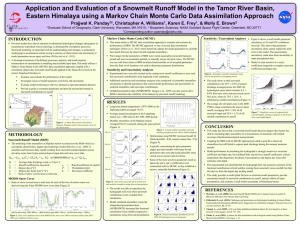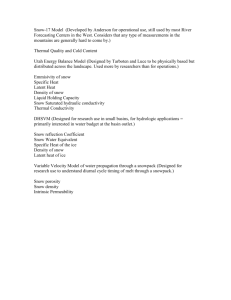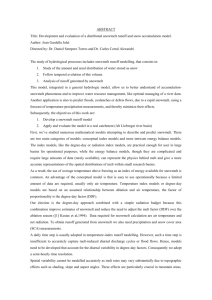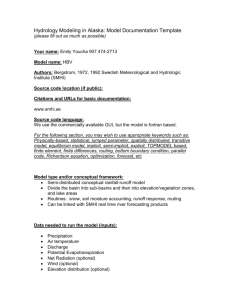Degree day models
advertisement
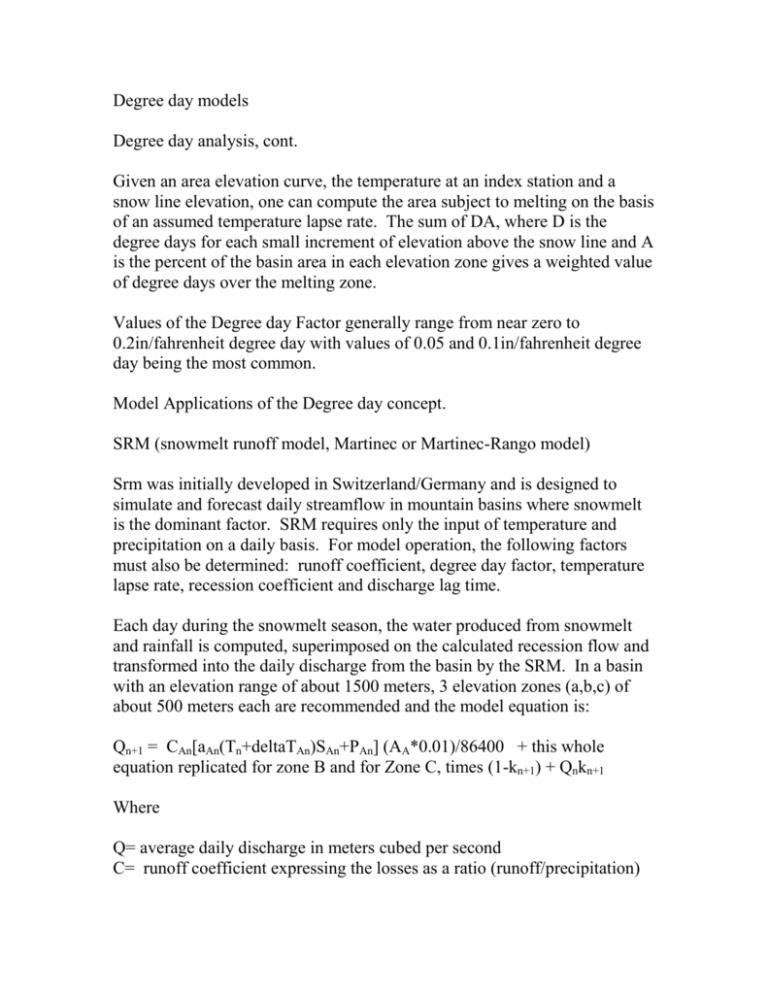
Degree day models Degree day analysis, cont. Given an area elevation curve, the temperature at an index station and a snow line elevation, one can compute the area subject to melting on the basis of an assumed temperature lapse rate. The sum of DA, where D is the degree days for each small increment of elevation above the snow line and A is the percent of the basin area in each elevation zone gives a weighted value of degree days over the melting zone. Values of the Degree day Factor generally range from near zero to 0.2in/fahrenheit degree day with values of 0.05 and 0.1in/fahrenheit degree day being the most common. Model Applications of the Degree day concept. SRM (snowmelt runoff model, Martinec or Martinec-Rango model) Srm was initially developed in Switzerland/Germany and is designed to simulate and forecast daily streamflow in mountain basins where snowmelt is the dominant factor. SRM requires only the input of temperature and precipitation on a daily basis. For model operation, the following factors must also be determined: runoff coefficient, degree day factor, temperature lapse rate, recession coefficient and discharge lag time. Each day during the snowmelt season, the water produced from snowmelt and rainfall is computed, superimposed on the calculated recession flow and transformed into the daily discharge from the basin by the SRM. In a basin with an elevation range of about 1500 meters, 3 elevation zones (a,b,c) of about 500 meters each are recommended and the model equation is: Qn+1 = CAn[aAn(Tn+deltaTAn)SAn+PAn] (AA*0.01)/86400 + this whole equation replicated for zone B and for Zone C, times (1-kn+1) + Qnkn+1 Where Q= average daily discharge in meters cubed per second C= runoff coefficient expressing the losses as a ratio (runoff/precipitation) [a= degree day factor (cm*degrees C*d) indicating the snowmelt depth resulting from 1 degree day. (the bracket in front of the little a is there simply to make it a ‘little’ a as this damn version or word insists on making it capital A each time I try.) T = number of degree days (Degrees C*d) Delta T = the adjustment (degrees C) by temperature lapse rate necessary because of the altitide difference between the temperature station and the average elevation of the basin or zone. S = ration of the snow covered area to the total area P = precipitation contributing to runoff (cm). A preselected threshold temp (Tcritical) determines whether this contribution is rainfall and thereby immeidate runoff or it is snowfall and thus delayed. 0.01/86400 = conversion from cm*m squared*d to meters cubed per second A = area of the basin in meters sq [k = recession coefficient indicating the decline of discharge in a period without snowmelt or rainfall (k=(Qm+1)/Qm) where m and m+1 are the sequence of days during a true recession flow period. [n = sequence of days during the discharge computation period. This equation is written for a temperature / flow lag time of 18 hours. As a result, the number of degree days measured on the nth day corresponds to the discharge on the n+1 day. Different time lags will result in the proportioning of the day n snowmelt between discharges occurring on days n, n+1 and possibly n+2. A, B, and C are elevation zones with the lowest being A and the highest C. Model variables and parameters: Basin characteristics. Elevation aones can be delineated in intervals of about 500 meters. An area elevation curve is used for determining the zonal hypsometric mean elevation by balancing the area above and below the mean. The mean value is used as the elevation to which the base station temperatures are extrapolated for the calculation of degree days per elevation zone. The number of degree days is determined daily as T=(tmax+tmin)/2. The degree day figures refer to the 24 hour period starting at 0600 hours with corresponding discharge referring to the periods shifted according to the time lag of the basin. All negative degree day values are taken as zero. SRM can also use either the average daily or an effective minimum approach. This second approach (which sets all negative Tmins to zero before entering the equation) allows the SRM to generate snowmelt in the early spring when a large nighttime depression of Tmin would normally cancel out any daytime Tmax which may reach as high as 10 to 15 degrees C. Precipitation: the measurement of REPRESENTATIVE precipitation amounts over a mountain basin is extremely difficult. Extrapolation of precipitation amounts form one or more base stations to zones in the basin must be based on user knowledge. If precipitation is determined to fall in the baisn on a given day, a critical temperature must determine whether the precip is rain or snow. This temp is usually selected to be sllightly aboe the freezing point and may vary from basin to basin. The distinction between rain and snow is important in SRM because rain contribution to runoff is on the same day of the event whereas snow contributions to Q is delayed. Snowfall: the affect is delayed. If the snow falls on the snow covered area, it is assumed to be part of the snowpack. If it falls on the snow free portion of the basin, it is assumed to be essentially precipitation not available for runoff but to be contributed as soon as a sufficient number (1 or more) of warm days or degrees days have accumulated. When precip falls as rain, it falls on a snow free area and becomes available for Q. when rain falls on snow, the effect on Q depends on the state of the snowpack. Early in the season, rain on snow is assumed to become part of the pack, thus not available for Q. at some stage during the snowmelt season, the snowpack is assumed to be ripe (user determined function) and the rain on snow is transferred thru the pack and become available for immediate Q. In SRM, the melting of snow from rain is assumed negligible. (thus for some areas such as the Pacific Northwest, this model, under some conditions, may be unsatisfactory) Snow coverage: the snow cover variable S, of a zone or basin is usually obtained from a depletion curve for input to the SRM. A variety of of sources of snowcover data can be used to compile the depletion curve including ground observation, landsat, photography, etc. For the snowmelt runoff simulation, daily snow cover values are taken from the depletion curves and input to the SRM. Snowstorms occurring during the snowmelt season can result in a temporary increase of snow cover but generally, with no significant hydrologic effect. The transitory new snow is accounted for as stored precipitation eventually contributing to Q. Runoff coefficient: because the runoff coefficient c, is likely to vary throughout the runoff season as a result of changing soil moisture conditions, the SRM permits changes in c every 15 days. Usually c is higher for snowmelt than for rainfall. IN some basins where runoff is concentrated into a very short time frame, c can approach 1.0, with prolonged snowmelt c may go down to 0.3. in addition, c may vary from zone to zone. The selection of c requires either good knowledge of the hydroclimatic characteristics of the basin and the model or trial and error in calibration. Degree day factor and lapse rate. The degree day factor ‘a’ is used to convert degree days to snowmelt expressed in depth of water. iN the absence of detailed temperature and snow pillow or lysimeter data, the degree day factor can be obtained from an empirical equation ‘a = 1.1(density of snow/density of water) The general seasonal increase in snowpack density can be used as an index of the seasonal increase of a. Large variations are expecteed if the melt season is long or there is a large difference in elevation in the basin. A typical range in ‘a’ is 0.25 –0.60 cm*degreeC*day. The fact that increasing ‘a’ is related to increasing snow density as nwomelt progresses is in response to a number of factors: higher densities are related to older snow with lower albedo, thus a higher ‘a’ value. In addition, higher densities are associated with increased liquid water in the pack and lower thermal quality. Because of the different stages of snowmelt at different elevation zones, the value of ‘a’ can be changed by zone. The calculated degree day values must be extrapolated from a base station to an elevation zone using a suitable lapse rate. DeltaT = l(hST-avgh) Where deltaT is the temperature lapse rate correction factor, degrees C ‘l = temperature laspe rate in degrees C per 100 meters hST = altitude of the temperature station in meters avgh (average h) = zonal hypsometric mean elevation in meters. Temperature lapse rates must be carefully determined (this is the guts of this model) especially if the base station is at a low elevation and extrapolation of the degree day is made only one direction (up). As the season progresses, lapse rates may change. When applying SRM, it is advisable to conduct a regional analysis of monthly lapse rates to determine the amount and extent of seasonal variation. Recession Coefficient: The recession coefficient k, depends on the current stream discharge. ‘kn+1 = xQny where Q is the daily discharge and the constants x and y must be determined for the given basin. For this determination, daily discharge values for the snowmelt season are used. The discharge Q on a given day Qn is always plotted against the value on the following day, Qn+1, whenever the hydrograph is falling. Once these points have been plotted for several years, an envelope line is drawn to enclose most of the points. This lower envelope line represents the extreme discharge decline i.e., the recession without any partial delay by possible precip or snowmelt. This lower envelope has been found to be valid on small basins, but on larger basins, the curve should be replaced by the average or best fit line. The average curve should be used on basins larger than 50 kilometers sq. This function basically shapes the recession limb of the hydrograph. Time Lag; this model has been written to run with a time lag of 18 hours between the rise in temperatuer and the rise of the hydrograph. If, observaationally, this is not correct, the computed discharge values must be moved ahead or behind accordingly. When calibrating the model, an overall/general best fit time lag is typically determined. This again is a parameter that can be adjusted seasonally as melt proceeds up elevationally and distances from the majority of the melt to the stream and or gaging station increase.

